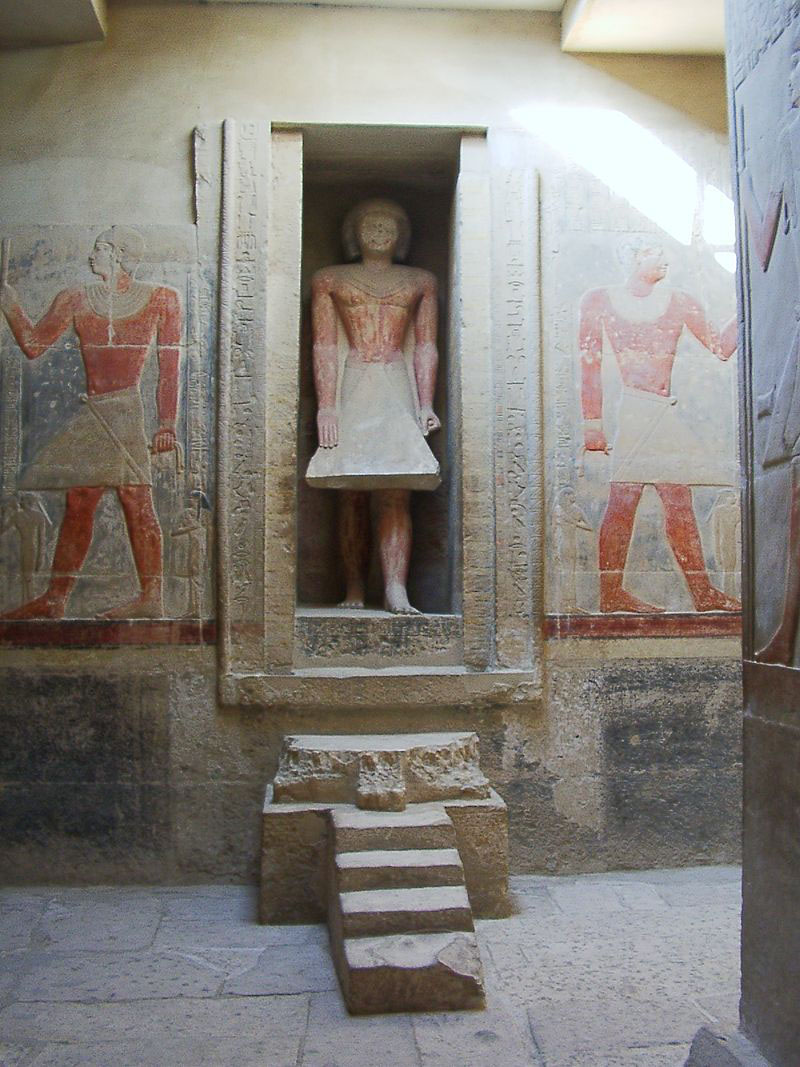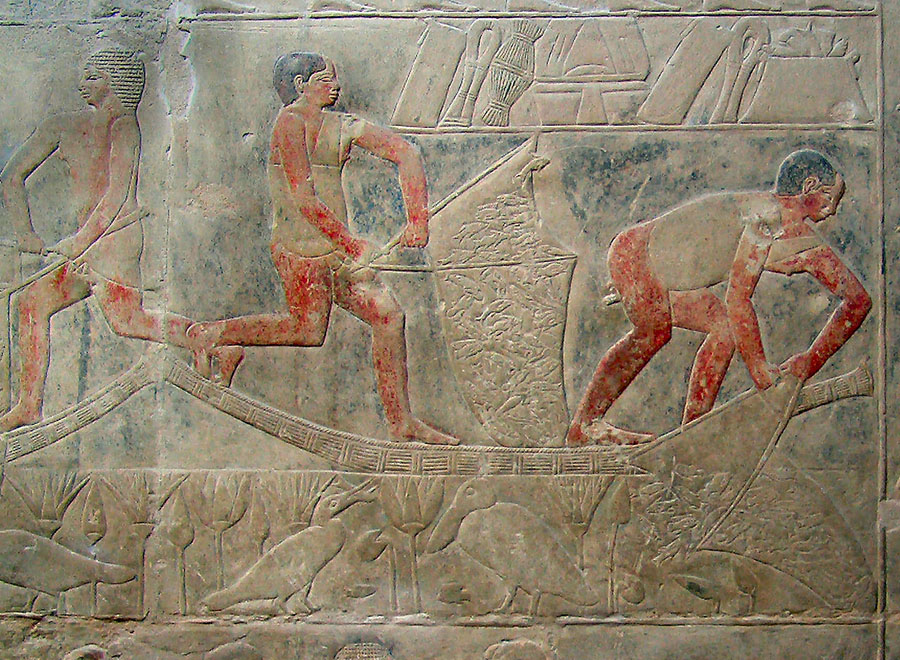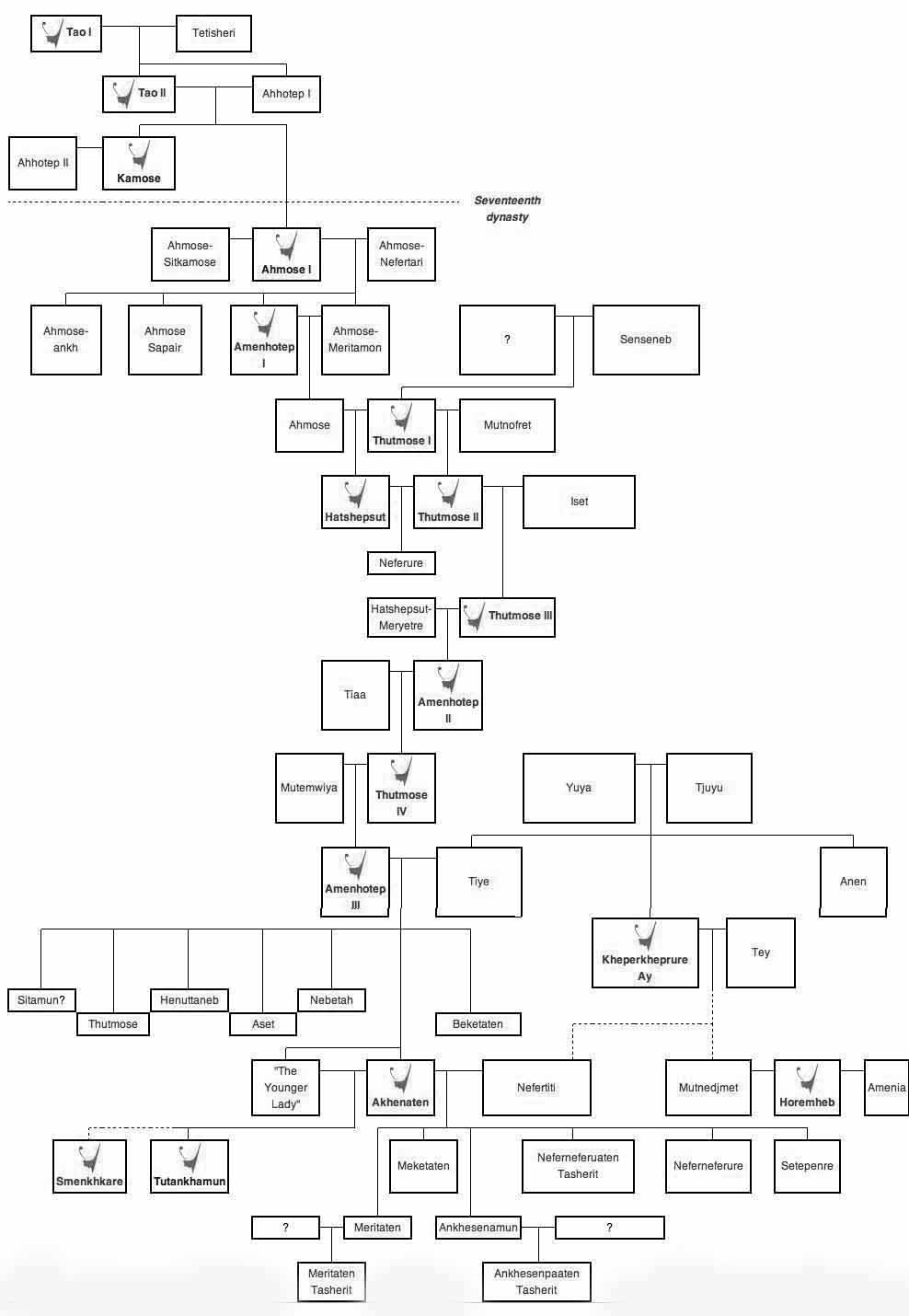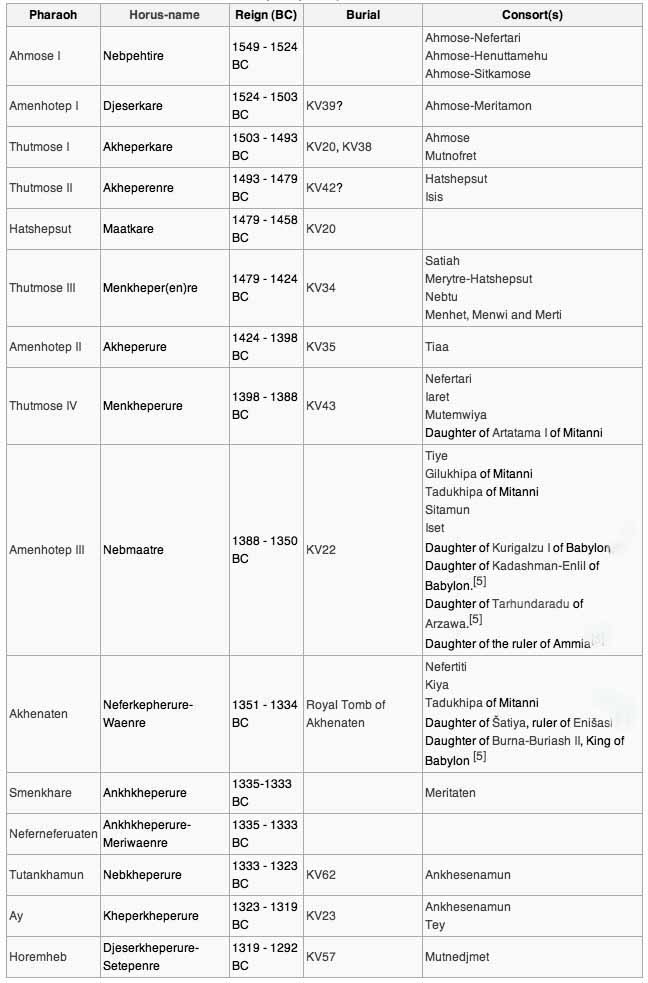

The Mastaba of Mereruka is the largest in Saqqara. It has 32 rooms.


Ahmose I
Amenhotep I
Tuthmosis I
Tuthmosis II
Queen Hatshepsut
Tuthmosis III
Amenhotep II
Tuthmosis IV
Amenhotep III
Akhenaten
Queen Nefertiti
Smenkhkare
Neferneferuaten
King Tutankhamen
Ay
Horemheb
The eighteenth dynasty of ancient Egypt (notated Dynasty XVIII) (c. 1550-c. 1292 BC) is perhaps the best known of all the dynasties of ancient Egypt. As well as boasting a number of Egypt's most famous pharaohs, it included Tutankhamun, the finding of whose tomb by Howard Carter in 1922 was a sensational archaeological discovery despite its having been twice disturbed by tomb robbers. The dynasty is sometimes known as the Thutmosid Dynasty because of the four pharaohs named Thutmosis (English: Thoth child).
As well as Tutankhamen, famous pharaohs of Dynasty XVIII include Hatshepsut (1479 BC - 1458 BC), longest-reigning queen-pharaoh of an indigenous dynasty, and Akhenaten (1353 - 1336 BC / 1351 - 1334 BC), the "heretic pharaoh", with his queen, Nefertiti.
Dynasty XVIII is often combined with Dynasties XIX and XX to form the New Kingdom period of ancient Egyptian history.
The pharaohs of Dynasty XVIII ruled for approximately two hundred and fifty years (c. 1550-1298 BC). The dates and names in the table are taken from Dodson and Hilton. Many of the pharaohs were buried in the Valley of the Kings in Thebes (designated KV). Several diplomatic marriages are known for the New Kingdom. These daughters of foreign kings are often only mentioned in cuneiform texts and are not known from other sources. The marriages were likely a way to confirm good relations between these states.
Dynasty XVIII was founded by Ahmose I the brother or son of Kamose, the last ruler of the Dynasty XVII. Ahmose finished the campaign to expel the Hyksos rulers.His reign is seen as the end of the Second Intermediate Period and the start of New Kingdom. Ahmose was succeeded by his son, Amenhotep I whose reign was relatively uneventful.
Amenhotep I probably left no male heir and the next Pharaoh, Thutmose I, seems to have been related to the royal family through marriage. During his reign the borders of Egypt's empire reached their greatest expanse, extending in the north to Carchemish on the Euphrates and up to Kurgus beyond the fourth cataract in the south. Thutmose I was succeeded by Thutmose II and his queen, Hatshepsut. She was the daughter of Thutmose I and soon after her husband's death, ruled for over twenty years after becoming pharaoh during the minority of her stepson, who later would become pharaoh as Thutmose III.
Thutmose III who later became known as the greatest military pharaoh ever, also had a lengthy reign after becoming pharaoh. He had a second co-regency in his old age with his son Amenhotep II. Amenhotep II was succeeded by Thutmose IV, who in his turn was followed by his son Amenhotep III. The reign of Amenhotep III is seen as a high point in this dynasty. Amenhotep III undertook large scale building programmes, the extent of which can only be compared with those of the much longer reign of Ramesses II during Dynasty XIX.
Amenhotep III may have shared the throne for up to 12 years with his son Amenhotep IV, who would change his name to Akhenaten. There is much debate about this proposed co-regency. Some experts believe there was a lengthy co-regency, while others prefer to see a short one. There are also many experts who believe no such co-regency existed at all.
In the 5th year of his reign Amenhotep IV changed his name to Akhenaten and moved his capital to Amarna. During the reign of Akhenaten the Aten - the sundisk - first became the most prominent deity, and eventually the Aten was considered the only god. If this amounted to true monotheism continues to be the subject of debate within the academic community.
Some state that Akhenaten created a monotheism while others point out that he merely suppressed a dominant solar cult by the assertion of another, while he never completely abandoned several other traditional deities.
Later Egyptians considered the so-called Amarna Period an unfortunate aberration. The events following Akhenaten's death are unclear. Individuals named Smenkhare and Neferneferuaten are known but their relative placement and role in history is still much debated. Tutankhamun eventually took the throne and died young.
The last two members of the eighteenth dynasty - Ay and Horemheb - became rulers from the ranks of officials in the royal court, although Ay may have married the widow of Tutankhamun in order to obtain power and she did not live long afterward. Ay's reign was short. His successor was Horemheb, a general during the reign of Tutankhamun whom the childless pharaoh may have intended as his successor. Horemheb may have taken the throne away from Ay in a coup. He was impotent and thus also died childless and appointed his successor, Ramesses I, who ascended the throne in 1292 BC and was the first pharaoh of the Nineteenth Dynasty.


The Mastaba of Mereruka is the largest in Saqqara. It has 32 rooms.


Mereruka served during the Sixth Dynasty of Egypt as one of Egypt's most powerful officials at a time when the influence of local state noblemen was increasing in wealth and power. Mereruka held numerous titles along with that of Vizier, which made him the most powerful person in Egypt after the king himself. Some of the other state titles which Mereruka held included 'Inspector of the priests attached to the pyramid of Teti', 'Governor of the palace', 'Chief lector-priest', 'Overseer of the royal record scribes' and 'Director of all the works of the king'.
The mastaba of Mereruka is the largest and most elaborate of all the non-royal tombs in Saqqara with 33 rooms or chambers in total. Mereruka was the vizier to king Teti, who was the first pharaoh of the 6th dynasty Old Kingdom period of Egypt.
Mereruka was married to Teti's daughter, princess Seshseshet Waatetkhethor. He was, therefore, the king's son-in-law. Princess Seshseshet Waatetkhethor is buried in Mereruka's mastaba tomb along with their son, Meriteti. The paintings on the wall in the entrance of the tomb show Mereruka painting the seasons and playing a board game.
The first three chambers are decorated with scenes of furniture making, hunting and goldsmith working. A lifelike statue of Mereruka was found intact within the principal chamber at the far end of his mastaba tomb. This chamber is approached through the mastaba tomb's false door.
Mereruka's mastaba tomb boasts vibrant and well preserved tomb decorations and numerous relief scenes. His mastaba tomb remained hidden from view until it was discovered and excavated by Jacques de Morgan, of the Egyptian Antiquities Service in 1892. However, the first major publication on his tomb did not occur until over 40 years later in 1936 by Prentice Duell. Mereruka was also known by his 'beautiful' or chosen name of Meri.
Twenty-one of the mastaba chambers are devoted to Mereruka himself, five are designated to his wife (chambers B) and five were added for his son Meriteti (or Meryteti) (chambers C). The overall external dimensions of Mereruka's mastaba are 23 metres east-west, 30 metres north-south (extending to 41 metres when one includes Meriteti's addition) and 4.5 metres high, while the internal height of the ceiling is just over 4 metres. Princess' complex at the left end of the tomb entrance to Mereruka's tomb depicts her "receiving offerings due to a king's daughter, including a selection of finely carved furniture" while she is shown relaxing and watching several dancing girls".
In another scene, "she is portrayed with her three dogs and a pet monkey." On the walls of chamber 7, Waatetkhethor is shown sitting together with Mereruka "on a large couch, while she plays her harp to soothe him". While most of the rooms of Mereruka's mastaba tomb were decorated, those which were left bare were simply used for storage.
A hunting scene within Egypt's marshes from Mereruka's tomb show five men punting "a papyrus raft along a verdant Nile bank, packed with reeds and teeming with wildlife" while nesting lapwings are depicted protecting their young from a marauding ichneumon, or type of mongoose, by either "spreading their wings over their chicks or by mobbing the intruder."
In the Nile river, one adult hippopotamus is shown seizing and killing a basking crocodile, "while behind it another crocodile turns the tables, waiting to devour a newborn hippopotamus." Other scenes show sculptors and carpenters of stone vases at work, while Mereruka and his wife are depicted inspecting a jeweller's workshop where some of the workers are dwarfs.


